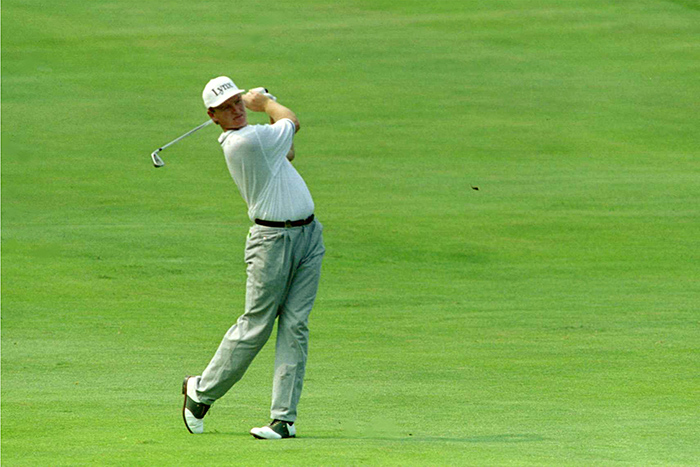Twenty-two years after Ernie Els won the 1994 US Open at Oakmont Country Club in searing 95-degree conditions, he was asked to sign a photo taken moments after his victory. He, Loren Roberts and Colin Montgomerie had shot five-under-par 279 to tie after 72 holes. Els and Roberts remained deadlocked after shooting 74s in their 18-hole Monday playoff, while Montgomerie was eliminated after carding a 78.
Els parred the second extra hole – Oakmont’s number 11 – of the ensuing hole-by-hole playoff to win. This came after Roberts holed a clutch 6-foot par putt on the first extra hole (number 10 on the course) to extend the playoff.
‘The photo shows the elation and the disappointment,’ Els said earlier this spring in his Jupiter office. ‘There’s Ricci (Roberts, Els’ caddie) and myself, with our arms up. There’s Loren and his caddie, with their shoulders slumped. That’s a picture of the two worlds of golf.’
Els, then 24, led by a stroke on the 72nd hole, something he didn’t know until later. Roberts had made a bogey that put Els ahead, but the score had not yet been posted on a nearby leader board. Els elected to hit a driver on the par-four closing hole.
‘I was running a bit hot,’ Els recalled. ‘I’d just three-putted 16 and missed a birdie putt on 17. I wanted to hammer a driver down there. I made a quick swing and hit a quick hook. I could have hit three-wood or two-iron and just had a longer club in.’
Els’ five-foot bogey putt got him into the Monday playoff after Roberts missed an uphill, four-foot par putt on the 72nd hole that would have won the championship. The bogeys that Els and Roberts made on 18 put Montgomerie, who had finished ahead of them, into the Monday cauldron.
It had been quite a week already. Arnold Palmer, then 64, played his final U.S. Open and gave an emotional press conference after missing the cut. That same Friday, Los Angeles police chased O.J. Simpson in his white Ford Bronco along area highways, as people across the country watched on television – coverage that interrupted the NBA Finals between the New York Knicks and Houston Rockets. The FIFA World Cup, played in nine cities across the U.S., started that Friday. The New York Rangers were celebrating their Stanley Cup victory with a ticker-tape parade down Broadway. ESPN found the confluence of events so dramatic that it produced one of its 30 for 30 documentaries on the subject, called, simply, ‘June 17, 1994.’
The next day, Els shot 66 to take a two-stroke lead over Frank Nobilo, three over Montgomerie, Roberts, Tom Watson and Hale Irwin.
To start the final round, Els missed the first fairway with his tee shot and the ball nestled in thick rough. Trey Holland, chairman of the USGA Rules Committee, deemed a camera mounted on a cherry picker in Els’ line of sight a ‘temporary immovable obstruction’ and allowed Els a free drop into rough that had been trampled down. The ruling was later deemed incorrect, because the cherry picker was on wheels and could have been moved.
‘I got the drop from the TV tower, but I still had to chip it out,’ Els said. ‘I still made bogey. There was a huge outcry, but I didn’t feel it was that big of a deal. If I hit it on the green and made par, then it would have been a huge break.’
Els received another free drop on the 17th hole when his drive on the 315-yard par four finished near a spectator stand behind the green. Els went to the drop zone, 15 yards nearer to the hole, and pitched to four feet but missed the birdie putt. The bogey on 18 ensued.
The three players started the Monday playoff in grim fashion, combining for two bogeys, three double bogeys and a triple bogey in the first five holes. Els bogeyed the first and made a triple-bogey seven on number two, ‘the shortest little par four, a three-iron and a wedge.’
Els’ tee shot found a decent lie in the first cut of rough.
‘I don’t know if it was morning dew,’ Els said, ‘but something was between the club and the ball. It went into a bush right behind the green. I was like, man, this is not happening. Then I drop it on the third tee (after taking an unplayable-lie penalty), and chip it all the way down from there, three-putt and make seven. I’m like, can we start again?’
Els told Roberts right there, ‘I knew I shouldn’t have made that 5-footer yesterday,’ to get into the playoff. But he shot 1 under par over the next 18 holes, including the playoff, to win the championship.
‘Somehow, it was meant to be,’ Els said. Ricci Roberts will be on his bag again this year at Oakmont when he makes his 24th U.S. Open appearance. He also caddied for Els when he won the 1997 U.S. Open at Congressional Country Club in Bethesda, Md.
Can he win again at Oakmont?
‘I look now, at my age, 46, and I think, I have a lot of experience,’ said Els, who also owns a pair of victories in The Open Championship, conducted by The R&A – he won in 2002 and 2012. ‘If I play properly, I have a chance. I’m looking forward to the challenge. There’s nothing like competing and doing well. But even the struggles are good. You’re grinding out there. I’ll keep playing until they tell me to leave.’
In 1994, Els left after 92 holes, with the U.S. Open Trophy.
By Lorne Rubenstein on usopen.com








